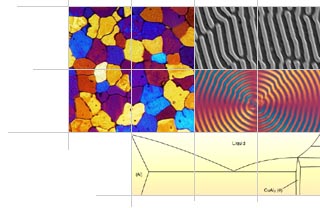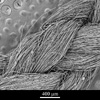Micrograph Library
Browse the libraryAdvanced searchSystemsCompositionsTechniquesKeywordsPhase diagramsHelpPreferencesAbout the micrograph libraryTerms of useContribute micrographs!FeedbackLinksCredits Print this page

Full Record for Micrograph 594

[146 KB]
View micrograph
.. in new window
View micrograph and record
.. in new window
You can also view and download the micrographs on Flickr
- Micrograph no
- 594
- Brief description
- Carbon string
- Keywords
- carbon, carbon fibres
 , composite material
, composite material  , fibre
, fibre  , polymer
, polymer 
- Categories
- Ceramic, Polymer
- System
- C
- Composition
- Not specified
- Standard codes
- Reaction
- Carbon fibres are produced by oxidising polyacrylonitrile in air at 230 deg C whilst applying tension, and then carbonising the product in nitrogen at 1000 deg C
- Processing
- Carbon string is woven from the fibres that result from the drawing of carbonised PAN
- Applications
- Carbon fibre composites are used as a structural material in the aerospace and automotive industries, as well as in certain high-performance sporting equipment. They present exceptional stiffness and can be structurally optimised for particular load-bearing applications.
- Sample preparation
- Technique
- Scanning electron microscopy (SEM)
- Length bar
- 400 μm
- Further information
- Carbon string is used as a conducting bridge in the preparation of specimens for observation in the scanning electron microscope (SEM). It is also representative of the preforms used in the manufacture of some carbon fibre based composite components. Fibres can be woven into appropriate shapes using traditional weaving technology. The preforms can then be injected with the resin matrix by processes such as resin transfer moulding (RTM) or resin film infusion (RFI).
- Contributor
- J A Curran
- Organisation
- Department of Materials Science and Metallurgy, University of Cambridge
- Date
- 03/10/02
- Licence for re-use
 Attribution-NonCommercial-ShareAlike 4.0 International
Attribution-NonCommercial-ShareAlike 4.0 International

